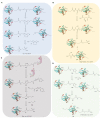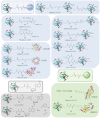Strategies to Target Specific Components of the Ubiquitin Conjugation/Deconjugation Machinery
- PMID: 31998698
- PMCID: PMC6966607
- DOI: 10.3389/fchem.2019.00914
Strategies to Target Specific Components of the Ubiquitin Conjugation/Deconjugation Machinery
Abstract
The regulation of ubiquitination status in the cell is controlled by ubiquitin ligases acting in tandem with deubiquitinating enzymes. Ubiquitination controls many key processes in the cell from division to death making its tight regulation key to optimal cell function. Activity based protein profiling has emerged as a powerful technique to study these important enzymes. With around 100 deubiquitinating enzymes and 600 ubiquitin ligases in the human genome targeting a subclass of these enzymes or even a single enzyme is a compelling strategy to unpick this complex system. In this review we will discuss different approaches adopted, including activity-based probes centered around ubiquitin-protein, ubiquitin-peptide and mutated ubiquitin scaffolds. We examine challenges faced and opportunities presented to increase specificity in activity-based protein profiling of the ubiquitin conjugation/deconjugation machinery.
Keywords: activity-based protein profiling; deubiquitinating enzymes; probe; protein modification; ubiquitin.
Copyright © 2020 Taylor and McGouran.
Figures


References
Publication types
LinkOut - more resources
Full Text Sources

